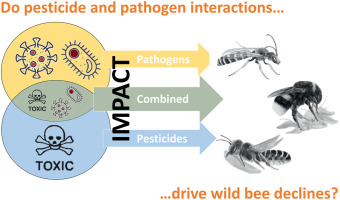
# **Study Reveals Climate Change Poses a Greater Threat to Wild Bees than Habitat Loss**
Wild bees are essential for ecosystem maintenance, primarily through their role in pollinating various plants, including many crops crucial for human sustenance. However, a recent study spearheaded by scientists at Penn State indicates that climate change is an even more significant risk to wild bee populations than habitat loss. Through the analysis of an extensive dataset, the researchers determined that solely tackling land-use alterations will not suffice to protect these vital pollinators.
## **The Effects of Climate Change on Wild Bee Populations**
A research team chaired by Christina Grozinger, Distinguished Professor of Entomology and head of the Center for Pollinator Research at Penn State, analyzed data accumulated over 14 years regarding wild bee populations in Maryland, Delaware, and Washington, D.C. Their results emphasize that fluctuations in temperature and precipitation are crucial factors impacting wild bee numbers and species variety.
> *“Our research showed that the primary determinant affecting wild bee numbers and species diversity was weather, specifically temperature and precipitation,”* remarked Grozinger.
### **Study Highlights**:
– Milder winters correlated with decreased bee populations, likely due to heightened pre-emergence weight loss and mortality rates.
– Increased rainfall diminished the number of spring bees, potentially because wet conditions hindered their food search.
– Scorching summers were associated with lower bee emergence in the subsequent year, possibly due to a decline in flowering plant availability.
These findings suggest that climate change, marked by extreme and variable weather, significantly influences wild bee populations.
## **Contrasting Climate Change with Habitat Loss**
Historically, conservation strategies have concentrated on preserving wild bee habitats by ensuring the availability of floral and nesting resources. Nevertheless, Melanie Kammerer, a graduate student in entomology at Penn State, points out that few studies have explored the combined impacts of climate change and habitat loss on wild bee populations.
> *“We believed this was a crucial gap since bees, like many organisms, face simultaneous habitat loss and climate change challenges,”* explained Kammerer.
Utilizing machine-learning models and specific climate metrics, the researchers discovered that climatic elements exert a more substantial influence on wild bee communities than habitat loss. Even in flower-rich and well-nested landscapes, adverse weather conditions detrimentally impacted bee populations.
## **Reasons for Wild Bees’ Vulnerability to Climate Change**
Wild bees are especially susceptible to environmental shifts due to their life cycles being closely aligned with seasonal variations. Changes in temperature and precipitation can affect:
– The timing of flower blooming, causing mismatches between bees and their food sources.
– Overwintering survival rates, as warmer winters may lead to increased energy loss and mortality.
– Reproductive success, as harsh heat or rain may hinder bees’ foraging and nesting activities.
Warmer winters and longer, more intense summers—predicted to occur more frequently due to climate change—will likely exacerbate these issues, further endangering bee populations.
## **Consequences for Bee Conservation**
The study’s findings indicate that conventional conservation efforts focused exclusively on habitat protection and restoration may fall short in addressing the decline of wild bees. Instead, approaches must also take into account the ramifications of climate change and strive to alleviate them.
An initiative designed to assist is **Beescape**, a project that enables farmers, conservationists, and gardeners to evaluate the landscape’s quality for bees at particular sites. The researchers intend to enhance Beescape to incorporate climate and weather data, offering a more thorough resource for conservation endeavors.
## **Looking Ahead: The Urgency for Action**
To effectively safeguard wild bees, researchers stress the necessity for:
– Increased long-term studies examining the combined impacts of climate change and habitat loss.
– Policies aimed at reducing carbon emissions to mitigate climate change effects.
– Conservation initiatives that integrate climate considerations into land management practices.
> *“We are only beginning to unravel the various ways in which climate affects bees,”* stated Kammerer. *“However, to conserve these essential pollinators, we must determine when, where, and how shifts in climate disrupt bee life cycles.”*
As climate conditions continue to exhibit unpredictable fluctuations, addressing both habitat loss and changing weather patterns will be critical for the survival of wild bee populations and, by extension, the ecosystems and agricultural systems they support.
### **References**
1. **Climate Change Reduces the Abundance and Diversity of Wild Bees** – SciTechDaily, 2021
2. **National Institute of Food and Agriculture** – USDA, 2021
3. **Climate Change and Wild Bees** – Penn State News, 2021
4. **Abundance and Diversity of Wild Bees Affected by Climate Change** – AZO CleanTech, 2021
By examining the combined pressures of climate change and habitat degradation, researchers and conservationists can devise more effective strategies to safeguard these crucial pollinators.